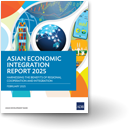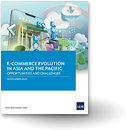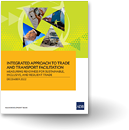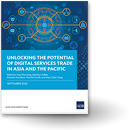Making Connections: How Asia’s Tourism Is Taking Off Again
Asia’s international tourism is steadily rebounding to near pre-pandemic levels. Strategic investments in transport infrastructure and streamlined visa policies are proving essential for boosting tourist flows and economic resilience.
International tourism is gradually recovering since the pandemic. At the global level, 2024 saw international travel recovering almost to pre-pandemic levels as 1.4 billion tourists traveled internationally (an 11% growth from 2023).
This is due to the improved economic performance of tourism source markets and the recovery of destinations in Asia. While international travel to the Middle East, Africa, and Europe surpassed their 2019 levels, the United States has regained 97% of pre-pandemic arrivals. Asia and the Pacific is not far behind.
Asia witnessed a recovery in its tourism arrivals with 323 million travelers visiting the region in 2024, a growth of 21% from 2023. This is equivalent to 88% of its 2019 volume (in 2023, the same was 72%).
Outbound tourism from the People’s Republic of China, once a major source of international visitors to Asian destinations, has not yet returned to pre-pandemic levels. By the end of 2024, outbound travel is expected to reach about 130 million travelers—roughly 90% of the 2019 figure.
As destinations in Asia enjoy a recovery, they are also revisiting their strategies to improve resilience through the development of new markets and improved connectivity. Cooperation in physical and institutional connectivity is a key factor.
For physical connectivity, air transport is an essential mode of travel in Asia and the Pacific, with at least 60% of visitors using air for their cross-border travel. However, within the region, the preferred mode of travel varies.
Although air transport was a primary mode of travel for the travelers in the Pacific, there has been an increase in the relative share of tourist arrivals by sea as well, reflecting the growing cruise tourism industry in the region.
In Southeast Asia, air transport is the predominant mode. While travel by air in Southeast Asia stood at 74% of the total arrivals in 2022, land was 15%, and by sea was 11%.
Strategic investments in transport and tourism infrastructure, paired with visa liberalization and regional cooperation, are key to accelerating Asia’s tourism recovery and boosting broader economic growth.
The geographical positioning of countries and regions plays an important role in deciding the mode of transport. For example, land transportation is significant in East and Central Asia, where destinations share common borders, such as Georgia and Türkiye. Singapore and Malaysia also see a high proportion of travelers via land transport.
Simultaneously, improved institutional connectivity facilitates greater tourism between countries and in a region. For example, in Southeast Asia, the liberalized policies for visa and air service agreements translate into greater travel within the region.
Implementation of ASEAN Open Skies in 2015 catalyzed the expansion of the low-cost carriers in Southeast Asia. Visa exemptions for the countries in the region has also encouraged movement of people across borders.
In addition, some countries in Southeast Asia (such as Indonesia, Thailand, and Viet Nam) have eased their visa requirements for countries outside the region, such as the People’s Republic of China and India.
Connectivity stimulates tourism flows. A 1% increase in air transport investment leads to a 0.98% increase in international tourism flows to Asia, and a 1.1% increase in intra-Asia tourism. Meanwhile, restrictive visa policies reduce international tourism flows to Asia by 52% and decrease intra-Asia tourism flows by 48%.
Investment in transport and tourism infrastructure—as well as reforms to improve cross-border institutional connectivity—are essential. Transport infrastructure is needed to develop links between tourism hubs and remote attractions.
Aside from enhancing physical infrastructure, pursuing a bilateral and subregional cooperation approach to ease air transport policies and encourage visa exemptions could be crucial in stimulating tourism flows among Asian countries.
Given that many of the countries in Asia are highly dependent on their tourism activities, a diversification strategy to other sectors should be considered. Inbound tourists increase consumption of goods and services, raising awareness and interest in local products, which in turn increases potential for higher merchandise exports and manufacturing growth.
It is estimated that a 1% increase in tourist inflows to the Pacific region is associated with a 0.17% rise in merchandise exports in the region. The gains can be larger if inbound tourists are from countries that enjoy an easy visa facility, speak a common language, and are part of trade cooperation arrangements with the destination countries.
These strategies and policy directions—especially those that harness the potential of bilateral and regional cooperation—not only support Asia’s economic recovery but also pave the way for diversifying source markets, enhancing competitiveness, and gradually strengthening the resilience of the region’s tourism sector.
Original article was published at the Asian Development Blog and duplicated here with permission from the authors. *




